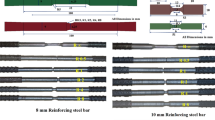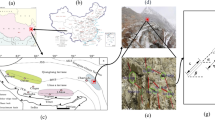Abstract
In this paper, strain-based damage assessment based on elastic-plastic FE analysis was carried out for the piping system test under seismic loads conducted at Bhabha Atomic Research Center (BARC, India) to suggest relevant damage evlaution method and cyclic hardening model. For the damage evaluation method, the cumulative plastic damage and cumulative fatigue damage assessment methods, suggested in ASME B&PV Sec. VIII and Sec. III, respectively, were considered. For the FE analysis, hybrid models consisting of the beam and solid elements were used, validated by comparing with the results using full solid models. To simulate the cyclic hardening behavior of the material, the bi-linear kinematic hardening model suggested in the JSME Code case and the Chaboche kinematic hardening model were considered. By comparing with test results, it is shown that predicted failure cycles are about 33–C;53 % of the test result, and the use of the cumulative plastic damage method is found to be more conservative than the cumulative fatigue damage method. The effect of the hardening model on evaluation results is found to be not so significant.
Similar content being viewed by others
Abbreviations
- α :
-
Back stress
- α L :
-
Material constant of the R-T model
- αsl, m2 :
-
Material constants of the ASME model
- a0, a1 :
-
Damping coefficients
- C :
-
Damping matrix
- Ci, γI :
-
Material constants of the Chaboche model
- D ε :
-
Cumulative plastic damage
- D εk :
-
Plastic damage at each loading point k
- D f :
-
Cumulative fatigue damage
- D f,k :
-
Fatigue damage at each cycle k
- E :
-
Young’s modulus
- E 2 :
-
Secondary slope of the bi-linear model
- ε pl :
-
Plastic strain
- ε p eq :
-
Equivalent plastic strain
- \({\varepsilon '^p}_{ij}\) :
-
Plastic strain rate tensor
- ε a :
-
Equivalent strain amplitude
- ε L,k :
-
Limiting triaxial strain at each loading point k
- ε LU :
-
Uniaxial strain limit
- ε max :
-
Maximum strain
- Δε p eq,k :
-
Change in the equivalent plastic strain
- K :
-
Stiffness matrix
- M :
-
Mass matrix
- Nk(εa):
-
Allowable cycle
- n k :
-
Number of repetitions of the k cycle
- ρ :
-
Density
- S m :
-
Stress intensity limit
- σ (1,2,3),k :
-
Principal stresses at each loading point k
- σ e,k :
-
Von-Mises equivalent stress at each loading point k
- σ m,k :
-
Hydrostatic stress at each loading point k
- σ y :
-
Yield stress of the bi-linear model
- σ y0 :
-
Initial yield strength at zero plastic strain
- V :
-
Volume
- v :
-
Poisson’s ratio
- ωi, ωi :
-
Natural frequencies of the structure
- ζ :
-
Damping ratio
References
G. Saji, Safety goals for seismic and tsunami risks: Lessons learned from the Fukushima Daiichi disaster, Nuclear Engineering and Design, 280 (2014) 449–463.
W. P. Chen, A. T. Onesto and V. DeVita, Seismic Fragility Test of a 6-inch Diameter Pipe System, NUREG/CR-4859, Washington DC, USA (1987).
G. DeGrassi, J. Nie and C. Hofmayer, Seismic Analysis of Large-scale Piping Systems for the JNES/NUPEC Ultimate Strength Piping Test Program, NUREG/CR-6983, Washington DC, USA (2008).
A. Ravikiran, P. N. Dubey, M. K. Agrawal, G. R. Reddy, R. K. Singh and K. K. Vaze, Experimental and numerical studies of ratcheting in a pressurized piping system under seismic load, Journal of Pressure Vessel Technology, 137 (2015) 031011.
A. Ravikiran, P. N. Dubey, M. K. Agrawal and G. R. Reddy, Experimental and Numerical Studies of Ratcheting in Pressurized Stainless Steel Piping Systems under Seismic Load, Bhabha Atomic Research Center, Mumbai, India (2015).
P. B. Labbe, G. R. Reddy, C. Mathon, F. Moreau and S. A. Karamanos, The OECD-NEA programme on metallic component margins under high seismic loads (MECOS), Proceedings of the ASME 2016 Pressure Vessels and Piping Conference, Vancouver, British Columbia, Canada (2016) PVP2016-63119.
J. W. Kim, I. H. Song, H. D. Kweon, J. S. Kim and Y. J. Kim, Evaluation of deformation and fracture behaviors of nuclear components using a simulated specimen under excessive seismic loads, Proceedings of the ASME 2018 Pressure Vessels and Piping Conference, Prague, Czech Republic (2018) PVP2018-84576.
ASME, ASME B&PV Code Sec. III Division 1-Subsection NB Class 1 Components, Rules for Construction of Nuclear Facility Components, New York, USA (2017).
J. S. Kim, S. H. Lee, H. D. Kweon and C. Y. Oh, Optimal finite element modeling technique for efficient time history seismic dynamic elastic-plastic analysis, Transactions of the Korean Society of Mechanical Engineers A, 42 (2018) 23–28.
H. D. Kweon, E. J. Heo, J. S. Kim, J. M. Lee, H. S. Nam, Y. J. Kim and J. W. Kim, Structural evaluation method for protection against failures of safety class 1 components under large seismic load, Transactions of the Korean Nuclear Society Spring Meeting, Jeju, Korea (2017).
J. S. Kim, S. H. Lee, Y. J. Kim, J. M. Lee, H. D. Kweon and E. J. Heo, A round robin analysis for developing strain-based structural integrity assessment procedure of nuclear components under beyond design basis earthquake, Transactions of the Korean Nuclear Society Spring Meeting, Jeju, Korea (2017).
H. D. Kweon, E. J. Heo, J. M. Lee and J. W. Kim, Strain-based damage evaluation of specimens under large seismic loads, Transactions of the Korean Society of Pressure Vessels and Piping, 14–2 (2018) 24–31.
S. K. Paul, S. Sivaprasad, S. Dhar and S. Tarafder, Key issues in cyclic plastic deformation: Experimentation, Mechanics of Materials, 43 (2011) 705–720.
A. Otani, T. Shibutani, M. Morishita, I. Nakamura, T. Watakabe and M. Shiratori, Seismic qualification of piping system by detailed inelastic response analysis: Part 2-A guideline for piping seismic inelastic response analysis, Proceedings of the ASME 2017 Pressure Vessels and Piping Conference, Waikoloa, Hawaii, USA (2017) PVP2017-65190.
J. L. Chaboche, K. Dang Van and G. Cordier, Modelization of the strain memory effect on the cyclic hardening of 316 stainless steel, 5th Structural Mechanics in Reactor Technology Conference, Berlin, Germany (1979).
J. L. Chaboche, Time-independent constitutive theories for cyclic plasticity, International Journal of Plasticity, 2 (1986) 149–188.
J. L. Chaboche, On some modifications of kinematic hardening to improve the description of ratchetting effects, International Journal of Plasticity, 7 (1991) 661–678.
SIMULIA User Assistance 2018, Dassault Systems, France (2017).
S. Goyal, S. K. Gupta, V. Bhasin and K. K. Vaze, Cyclic plasticity and fatigue-ratcheting behavior of SS304LN stainless steel material, Transactions of SMiRT 21, New Delhi, India (2011).
S. K. Paul, S. Sivaprasad, S. Dhar and S. Tarafder, True stress-controlled ratcheting behavior of 304LN stainless steel, Journal of Materials Science, 47 (2012) 4660–4672.
S. C. Kulkarni, Y. M. Desai, T. Kant, G. R. Reddy, P. Prasad, K. K. Vaze and C. Gupta, Uniaxial and biaxial ratchetting in piping materials-experiments and analysis, International Journal of Pressure Vessels and Piping, 81 (2004) 609–617.
R. W. Clough and J. Penzien, Dynamics of Structures, 3rd Ed., Computers & Structures, Inc., California, USA (1995).
ASME, ASME B&PV Code Sec. VIII Division 2-Alternative Rules, Rules for Construction of Pressure Vessels, New York, USA (2017).
J. R. Rice and D. M. Tracey, On the ductile enlargement of voids in triaxial stress fields, Journal of Mechanics and Physics of Solids, 17 (1969) 201–217.
J. A. Bannantine, J. J. Comer and J. L. Handrock, Fundamentals of Metal Fatigue Analysis, 1st Ed., Prentice-Hall, Inc., New Jersey, USA (1990).
ASME, ASME B&PV Code Sec. III Appendices, Rules for Construction of Nuclear Facility Components, New York, USA (2017).
V. Polenta, S. D. Garvey, D. Chronopoulos, A. C. Long and H. P. Morvan, Effects of pipe curvature and internal pressure on stiffness and buckling phenomenon of circular thin-walled pipes, International Journal of Mechanical, Aerospace, Industrial and Mechatronics Engineering, 9–2 (2015) 278–282.
B. G. Teng, L. Hu and S. J. Yuan, Deformation behavior of thin-walled tube bending with internal pressure, Reviews on Advanced Materials Science, 33 (2013) 436–441.
Acknowledgments
This work was supported by the Nuclear Power Core Technology Development Program of the Korea Institute of Energy Technology Evaluation and Planning (KETEP) granted financial resource from the Ministry of Trade, Industry & Energy, Republic of Korea (No. 20171520101650).
Author information
Authors and Affiliations
Corresponding author
Additional information
Recommended by Editor Chongdu Cho
Dong-Joo Chang is a master student of the Department of Mechanical System Design Engineering, Seoul National University of Science and Technology, Korea. He received his B.S. degree in the Mechanical System Design Engineering from Seoul National University of Science and Technology in 2019. His research interests include structural integrity assessment based on computational mechanics of materials.
Jong-Min Lee is a Ph.D. candidate of the Mechanical Engineering, Korea University, Korea. He received his B.S. degree in the Mechanical Engineering from Korea University in 2016. His research interests are in applying the current structural integrity assessment procedure based on fracture mechanics to computational structural analysis.
Nam-Su Huh received his B.S., M.S. and Ph.D. degrees in the Mechanical Engineering from Sungkyunkwan University, Korea, in 1996, 1998 and 2001, respectively. He is currently a Professor at the Department of Mechanical System Design Engineering, Seoul National University of Science and Technology, Korea. Prof. Huh’s research interests include structural integrity assessment based on computational mechanics of materials.
Rights and permissions
About this article
Cite this article
Chang, DJ., Lee, JM., Nam, HS. et al. Effect of damage evaluation method and cyclic hardening models on strain-based fatigue assessment to a piping system under seismic loads. J Mech Sci Technol 34, 2833–2844 (2020). https://doi.org/10.1007/s12206-020-0616-3
Received:
Revised:
Accepted:
Published:
Issue Date:
DOI: https://doi.org/10.1007/s12206-020-0616-3




